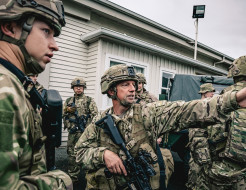
Army Reservists to be tested in challenging annual exercise
03 July 2025
Unfortunately you are viewing this website on an outdated browser which does not support the necessary features for us to provide an adequate experience. Please switch to a modern browser such as latest version of Google Chrome, Mozilla Firefox, Apple Safari or Microsoft Edge.
Ngā mihi nui
If we want to keep New Zealand safe and secure, and also help with the safety and security of those who depend on us, we have to have the equipment, people and skills necessary to go into combat if required.
The government requires us to be ready to conduct combat operations. To do this we must be capable of using force and protecting ourselves in environments where threats may cause us harm. The work that goes into maintaining combat readiness is at the heart of what we do as an organisation, giving us the skills, tools and resilience to respond to any situation when called upon. Combat is our job and we train to be excellent at it. While we always hope that the fight can be avoided, we must be ready to fight – and prevail – when New Zealand needs us.
These area some of our stories
Our other areas of work